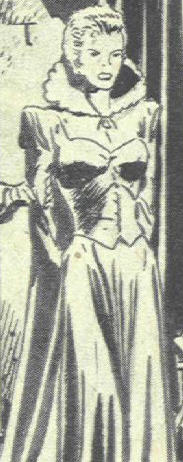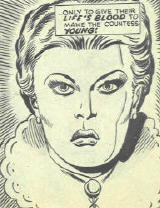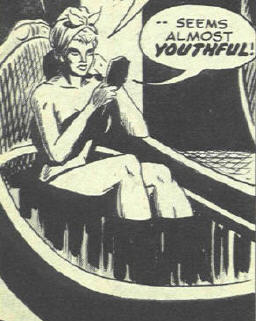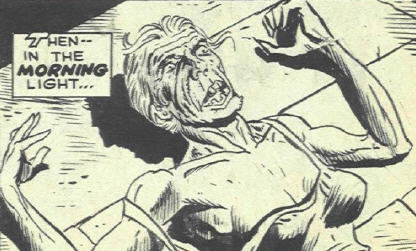 BLOOD COUNTESS
BLOOD COUNTESS
 BLOOD COUNTESS
BLOOD COUNTESS
Real Name: Erzsebet Bathory (later Christianized to Elizabeth Bathory)
Identity/Class: Human (@ 16th-17th Century) magic user; Hungarian
Occupation: Former Countess of Hungary
Affiliations: Dorka Szentes; Iloona Joo; Johannes Ujuvary; Anna Darvulia; Damien Thorko; also used a number of servants
Enemies: Dracula; King Mathias of Hungary, Count Gyorgy Thurzo; some 600 victims, mostly teenage Hungarian girls in the early 17th century
Known Relatives: George/Gyorgy (father, deceased), Anna (mother, deceased), Stephen I (uncle,deceased), Andreas, Gabor, George Thurzo (cousins, deceased), Stephen II (brother, deceased), General Ferencz Nadasdy (husband,deceased), Anna, Katherina, Ursula (daughters, deceased), Paul (son, deceased), Anastasia (daughter born out of wedlock, deceased)
Aliases: Elizabeth Bathory; Countess Dracula (erroneously, See Comments), Countess Bathory
Base of Operations: Csejthe Castle, Hungary, Nove Mesto, Czechoslovakia; formerly Sarvar Castle, Sarvar, Austria, 1560-1614 AD
First Appearance: Dracula Lives#4, fifth story (January 1974)

Powers/Abilities: The Blood Countess regained and maintained
her youth by bathing in the blood of virgin women. This also apparently granted
her immunity to control by Dracula and presumably other vampires.
She was aided by a large number of associates who assisted her in procuring and slaying
her victims.

History: (historical) - Elizabeth Bathory was born in 1560 as a member of the Hungarian Hunyadi aristocracy. Her uncle Stephen I was a Transylvanian prince and later King of Poland in 1576. Lord Palatine of Hungary, Count Gyorgy (George) Thurzo, was also related to the Bathorys. Throughout the generations, however, the family began to run a wide streak of madness and a taste for a decadence with sexual deviants, sadists, masochists, witches, heretics, and intellectuals festering throughout the family tree.
At age eleven, Elizabeth was already betrothed to Fernencz Nadasdy, the scion of another prominent Protestant family. After the death of her father, she was already being taught by one of her relatives how to practice witchcraft and recognize the mystical properties anathema in the Christian world. To free Elizabeth from their relatives influences, her mother sent her to live with the Nadasdy family where she could be groomed to her future role as a countess.
By all accounts, Elizabeth was a precocious child. She soon became bored with the domestic routine and found secret thrills in playing with the peasant boys on the estate. Pregnant at the age of thirteen, she was retrieved under the guise of an illness by her mother and taken into seclusion. Her newborn child quickly spirited out of the country, Elizabeth became joined in wedlock to Nadasdy at Varanno Castle shortly after her fifteenth birthday. The ceremony was attended by Holy Roman Emperor Maximilian II of Hapsburg, the son of Ferdinand I, an ally of Nadasdy's father.
After the wedding, the newlyweds made their residence in Castle Sarvar in Northwest Hungary rather than in any of the more salubrious houses owned by their families. Very early in the marriage, Elizabeth refused to take Nadasdy's family name, insisting that she be called by her maiden name of Bathory. Apparently this had no effect on her husband, who was already off campaigning in war against the invading Turks and making a name for himself as the "Black Hero" of Hungary. Left to her own devices, Elizabeth began engaging in affairs with numerous lovers as a pastime. Shortly before her husbands return, she vanished from Sarvar with one of her lovers who was supposed to be a nobleman. (This nobleman may or may not have been Dracula, who was already a vampire at the time and who Elizabeth has claimed to have been acquainted with in an otherwise unrevealed encounter.)
Returning home to Sarvar, Nadasdy discovered his wife's absence, but he expressed no emotion when she returned. Hardly distressed over her absence, he merely demanded that she submit her role as a wife and provide him with a suitable heir in the event that she should disappear again. Obliging without an argument, Elizabeth gave birth to a child once every four years. To insure his wife's fidelity, however, Nadasdy had his mother come to stay at Sarvar which began to prey at Elizabeth's emotions.
To vent her hatred for her mother-in-law, Elizabeth began exerting her temper on her female servants, especially if they were bosomy and younger than fifteen. Concentrating on new and inventive ways to pleasure herself through the pain of others, she elaborated on the frequent beatings that she and her most trusted confidants administered on her servants.
Searching for ways to save her already flagging youth and beauty, Elizabeth engaged the services of Anna Darvulia, a witch, to concoct magic elixirs for her. Her taste for blood originated on a day when one of her hand-maids made a mistake when combing her hair. Ablaze with anger, the countess struck the girl in the face, drawing blood that splashed back on her. Bathory then noticed to her immense delight that when she wiped off the blood, her skin seemed softer and younger. She then believed that she had discovered the secret to remaining young; she must bathe frequently in human blood.
When General Nadasdy died in the winter of 1604, supposedly of natural causes, Elizabeth, freed of marital concerns, quickly dismissed her mother-in-law. For the next ten years, she and Darvulia; along with Ilona (Helena) Joo, a witch; Dorka (Dorothea) Szentes, a sadist; Johannes Ujuvary, the major-domo with skills in alchemy; and a male witch named Damien Thorko began carrying out their torture sessions to their most fatal extremes in the dungeons under Csejthe Castle. Abducting young girls by the dozens, they tortured the girls by draining their blood off for Elizabeth's blood baths, then dumping the remains beyond the castle ramparts. As threat of the Turkish Armies advanced closer, however, Countess Bathory and her staff moved their residence to Lobkowitz Square in Vienna.
In the cellar of her Vienna Mansion, she had installed a new form of torture in which girls were locked into a loose-fitting spike-lined iron maiden that hoisted above the Countess. Prodded by a red hot poker, the victims often flailed about against the spikes, while the Countess sat below them, showering and sometimes drinking the girls' blood. When the blood baths failed to stem the onslaught of middle age, Elizabeth decided to turn to blue-blooded victims, young ladies of noble birth, a supply much more difficult to obtain.
During the height of the Countess' madness in Vienna, disposing of bodies without attracting attention became virtually impossible and her helpers became forced to simply dump the drained victims in a field. As numerous bodies continued to be discovered, frightened villagers who had long suspected Bathory were emboldened enough to complain to authorities.
On New Years Eve, 1610, Holy Roman Emperor Matthias II, the son of Maxmilian II, sent Elizabeth's cousin, Lord Palatine George Thurzo to question her. Anxious to preserve the family from disgrace, Thurzo personally questioned his cousin before arresting her accomplices. Maintaining a defense of interrogation, Bathory freely admitted to the tortures that she had put forth on the abducted girls. Johannes Ujuvary testified to a list written by the Countess of girls and young women who had been killed, putting their number at no fewer than 650.
In January 1611, a five-day trial held in the town of Bicshe (Byca, Czechoslovakia) sentenced the Countess' accomplices to public execution. Her name having been mentioned only once in the proceedings, Countess Bathory was quietly locked away in Csejthe Castle. Walled up with only a small food hatch connected to the outside, Elizabeth Bathory allegedly died in August 1614.
The trial documents about her tortures eventually became part of the Budapest State Archives as a means of covering up the actual horrifying truths of the trial. In 1729, a Jesuit priest, father Laszlo Turoczy, in liege to reconverting the Hungarians back into the Roman Catholic Church, uncovered the documents of the Countess' blood baths and made public information of them.
(Dracula Lives#4, fifth story) <1606> - Bathory brutally whipped
a servant girl after she fled punishment after breaking a plate. During the
course of the flogging, Bathory lacerated the girl's skin and was sprayed
with her blood. Bathory had her other servants kill the girl, but later that
evening, she realized that the spots on her skin that had been touched by
the blood had regained their youthful appearance. Realizing she had discovered
a means to eternal youth, Bathory began having a number of girls from adjacent
lands kidnapped or hired as servants. She had the girls slain and bathed
in their blood, eventually regaining her full youth and former
beauty.
Unbeknownst to Bathory, however, the vampire lord Dracula had observed her
actions, seeking to eliminate a competitor for the local blood supply. Dracula set a trap for Bathory, leaving a
screaming servant girl tied to
a tree. As predicted, the sounds of a potential victim drew the Countess
and her servants. Dracula slaughtered her servants and then bit Bathory,
intending to make her his slave. However, the bloodbaths had somehow rendered
her immune to his control. Realizing she could not stand against the Lord
of the Undead, she instead offered an alliance, promising to share her victims
with him. She outfitted Castle Csejthe with a coffin filled with Transylvanian
soil, which Dracula could sleep in during the daytime hours. Once he was asleep, however,
she had the coffin bound in garlic to keep him imprisoned in it.
 Although pained by
the garlic, Dracula managed to turn to mist and escape the rotted floor of
the coffin. Rather than simply kill her, Dracula sought to punish her betrayal
by seeing her disgraced--her name made a byword for horror. He then located
and stole Bathory's journal which detailed the girls from whom she had taken
blood. After seeing that her depravity had extended beyond servant girls
and into noblewomen, Dracula had portions of the journal sent to King Mathias
of Hungary and Count Gyorgy Thurzo, the governor of the province.
Although pained by
the garlic, Dracula managed to turn to mist and escape the rotted floor of
the coffin. Rather than simply kill her, Dracula sought to punish her betrayal
by seeing her disgraced--her name made a byword for horror. He then located
and stole Bathory's journal which detailed the girls from whom she had taken
blood. After seeing that her depravity had extended beyond servant girls
and into noblewomen, Dracula had portions of the journal sent to King Mathias
of Hungary and Count Gyorgy Thurzo, the governor of the province.
Elizabeth Bathory was brought to trial and, as per her sentence, walled up within her own castle for the rest of her life. Eventually, Dracula
completed his revenge, entering her prison through a small window and draining
her blood. The effects of the blood she had bathed in faded as her blood
was removed, leaving her once again a withered hag.
Comments: Based on the real person. Adapted by Gardner F. Fox and Dick Ayers.
It wasn't quite clear whether Dracula slew Bathory, but if he did then there's no good reason why she couldn't have risen as a true vampire. Since Bathory could resist Dracula as a human, she might be able to as a vampire, as well. That being said, I think there's another untold story of Dracula from centuries past. Would she seek vengeance? Of course she would!
Bathory's journals were discovered in the modern era (or close
to it) by the voodoo gougan Mama Limbo. In Tales of the Zombie
#6's "End
of a Legend" (fifth story), Limbo sought to repeat Bathory's practices.
She required four
beautiful virgins to restore her own youth, but Brother Voodoo stopped her
before she could claim the fourth, Loralee Tate.
Thanks to Per
Degaton for pointing that issue out. I had
long forgotten it.
Also, courtesy of Per Degaton:
Paraphrasing Carycomic@aol.com, he adds:
The cult film "Countess Dracula" (mentioned above) might have been so entitled for more than just commercial reasons. If memory serves me correctly, the historical Vlad Tepes' own cousin Stephen (See Bathory's Known Relatives listed above) was probably the closest mutual relative of the Tepes clan and the aristocratic Hunyadi family of Hungary (Bathory's familial ancestry), making Vlad and the historical Bathory distant relations of some sort. This would explain the alias of Countess Dracula, as well.--Kyle
Here's some excellent info courtesy of the Straight Dope:
Also, our own Will U promises he's got a boatload more info on the Blood Countess, so keep checking back here. It'll probably make it in a month or two, and we'll add it to the updates page.
Profile updated/edited by Kyle Sims
CLARIFICATIONS:
No known connection to:
Appearances:
Dracula Lives#4/5 (January, 1974) - Gardner F. Fox (writer), Dick Ayers (artist), Roy Thomas (editor)
First Posted: 11/22/2002
Last updated: 06/26/2003
Any Additions/Corrections? please let me know.
All characters mentioned or pictured are ™ and ©
1941-2099 Marvel Characters, Inc. All Rights Reserved. If you like this stuff,
you should check out the real thing!
Please visit The Marvel Official Site at:
http://www.marvel.com
Special Thanks to www.g-mart.com for hosting the Appendix, Master List, etc.!